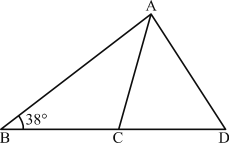Practice Model questions set 2 - quantitative aptitude Online Quiz (set-1) For All Competitive Exams
Q-1) Using the data in the above question, what is the breadth of the rectangle ?
(a)
(b)
(c)
(d)
Breadth of the rectangle is 8 units, as solved above
Q-2) Let LMNP be a parallelogram and NR be perpendicular to LP. If the area of the parallelogram is six times the area of ΔRNP and RP = 6 cm what is LR equal to?
(a)
(b)
(c)
(d)
![]()
Area of parallelogram = 6 × Area of ΔNPR
∴ NR × PL= 6 × $1/2$ × NR × PR
⇒ PL = 3PR (here, PL = PR + RL)
⇒ PR + RL= 3PR
⇒ RL= 2PL = 2 × 6 = 12 cm
Q-3) The length of a minute hand of a wall clock is 9 cm. What is the area swept (in $cm^2$) by the minute hand in 20 min? (take π = 3.14)
(a)
(b)
(c)
(d)
The angle made by the minute hand in 20 min = 120°
∴ The area swept by the minute hand in 20 min
= $θ/{360°} × π r^2 = ∼ {120°}/{360°} × 3.14 × 9 × 9 = 84.78 cm^2$
Q-4) In a Δ ABC, AD is the median through A and E is the mid– point of AD and BE produced meets AC at F. Then, AF is equal to
(a)
(b)
(c)
(d)
In ΔABC, we draw a line l || BF which intersect AC at G. In ΔADG and ΔAEF;
given that EA is the mid point of AD and DL || EF.
So, concept of similar triangle.
F is also mid point of AG. AF = FG (i)
DADG and DAEF are similar.
Again
ΔFBC and ΔDCl
BF || DG
given that AD is median so thad DB the mid point of BC.
G will be The mid point of CF
CG = GF ...(ii)
From equations (i) and (ii), we get
AF = FG = CG ...(iii)
From figure, AC = AF = FG + CG
= AF + AF + AF + 3AF
⇒ AF = $1/3$ AC
Q-5) A cardboard sheet in the form of a circular sector of radius 30 cm and central angle 144º is folded to make a cone. What is the radius of the cone?
(a)
(b)
(c)
(d)
length of the are = 2 π r $(θ/{360º})$
Radius of arc(r) = 30 am
Length of the arc = 2πr = 2π × 30 × ${144}/{360}$ = 24π
Let the radius of the cone = R ∴ 2πR = 24π
⇒ R = ${30 × 144}/{360}$ = 12cm
Q-6) ABC and XYZ are two similar triangles with ∠C = ∠Z, whose areas are respectively 32 $cm^2$ and 60.5 $cm^2$ . If XY = 7.7 cm, then what is AB equal to?
(a)
(b)
(c)
(d)
We know that when two triangles are similar then ratio of their areas is equal to square of corresponding sides.
![]()
${\text"area of ΔABC"}/{\text"area of ΔXYZ"} = {AB^2}/{XY^2} ⇒ {32}/{60.5} = {AB^2}/{(7.7)^2}$
⇒ ${32 × 59.29}/{60.5} = AB^2 ⇒ 31.36 = AB^2$
∴ AB = $√{31.36}$ = 5.6 cm
Q-7) The lengths of three line segments (in cm) are given in each of the four cases. Which one of the following cases is not suitable to be the three sides of a triangle?
(a)
(b)
(c)
(d)
We know that, in any triangle the sum of two sides is always greater than its third side and the difference of two sides is always less than its third side.
Only option (c) is not satisfy the above conditions
(i) 2 + 3 ≯ 5 (ii) ∼ 5 – 2 ≮ 3
Q-8) In the figure given below, what is ∠BCD equal to?
(a)
(b)
(c)
(d)
∠BAC = ∠BDC {Angle made by same chord BC in the same side}
Now, from ΔBCD, sum of angles = 180°
∠CBD + ∠BDC + ∠BCD = 180°
∴ ∠BCD = 180° – 100° = 80°
Q-9) In the figure given below, ABC is a triangle. BC is parallel to AE. If BC = AC, then what is the value of ∠CAE?
(a)
(b)
(c)
(d)
Given that, BC || AE
∠CBA + ∠EAB = 180°
⇒ ∠EAB =180° – 65° = 115°
∵ BC= AC
Hence, ΔABC is an isosceles triangle
![]()
∠CBA= ∠CAB = 65°
Now, ∠EAB = ∠EAC + ∠CAB
⇒ 115° = x + 65° ⇒ x = 50°
Q-10)  In the figure given, ∠B = 38°, AC = BC and AD = CD. What is ∠D equal to?
In the figure given, ∠B = 38°, AC = BC and AD = CD. What is ∠D equal to?
(a)
(b)
(c)
(d)
Given, AC = BC
![]()
In ΔABC, ∠ABC = ∠CAB
∠ABC = ∠CAB = 38° (∴ AC = BC)
∠ACB = 180° – (∠ABC + ∠CAB)
= 180° – (38° + 38°) = 180° – 76° = 104°
In ΔACD, ∠ACD = 180° – 104° = 76°
and ∠ACD = ∠CAD = 76°
(∵ CD = AD)
∴ ∠ADC = 180° – (∠ACD + ∠CAD)
= 180° – (76° + 76°) = 28°